Utah County Birders Newsletter
|
 |
Contents
July Meeting
Upcoming Field Trips
Captainís Log
Bird of the Month
Field Trip Report -
River Lane
Backyard Bird of the Month
June Hotline Highlights
JULY MEETING:
Our monthly meeting will be canceled on its
regular date in exchange for a bird walk on the evening of
July 23rd at 7pm. We are going to meet in the
parking lot at Vivian Park (South Fork
turnoff) up Provo Canyon and walk a short ways down the bike trail, birding
along the Provo River. Bring bug spray as that area can get pretty buggy.
Saturday, July 11th, 2015. Mirror Lake Highway - 6:30 am - Machelle Johnson will lead a field trip to Mirror Lake. Meet in the Orem Harmon's parking lot (870 E 800 N, Orem) at 6:30am, we will carpool from there. There is a $6.00 per vehicle fee to enter the area. Bring snacks and/or lunch and water as well as bug spray and sunscreen. We'll head home around mid-afternoon.
Thursday,
July 23rd, 2015.
7:00 pm - Evening bird walk at
Vivian Park. We are going to meet in the
parking lot at Vivian Park (South Fork
turnoff) up Provo Canyon and walk a short ways down the bike trail, birding
along the Provo River. Bring bug spray as that area can get pretty buggy.
Vivian Park
We are actively recruiting people to lead local half-day field
trips, any time, any place. If you would like to lead a field trip or if you
have any ideas for this yearís field trips, please contact Bryan Shirley at -
bt_shirley@hotmail.com
Utah County Birders Captainís Log:
July 2015
by Keeli Marvel
The July doldrums are upon us. Hope yaíll are keeping cool out there and seeing
some birds in spite of the record breaking temperatures!
I recently had a friend tell me of how she and her husband watched proudly as a nest of robin hatchlings fledged in her yard and how careful they were not to touch the young, even as they helped one that had been trapped behind their woodpile. I commended her for her efforts and congratulated her on the success of the nest in her yard. Then we had a nice discussion on the topic of bird scent. I think a lot of people have the misconception that if you touch baby birds, your scent will rub off on them, and then the parents will no longer accept them. Iíve heard this several times frequently, so I thought Iíd help dispel the myth.
Iíve always been taught that most birds do not have a well-developed sense of smell. Iíll tell you why the data is no longer supporting that theory in a minute. In this situation, however, American Robins in particular, and many of our common song birds, in general, do not seem to be bothered by human scent. This means that if you find a baby bird out of a nest and it canít fly yet, one of the best things you can do is put it back in its nest and the parents (who are often standing by anxiously) will continue to feed and care for it. If the nest is gone, you can also put the baby bird in a small box or other soft container and place it up in a tree or bush where you think the nest may have been. In most cases, the parents should return to care for their young. Newly fledged birds that are capable of flight will commonly spend a few days after fledging from the nest on the ground, and at that point they benefit most from us if we just keep our distance, keep our pets away from them, and let them do their thing. For more information, the Cornell Lab of Ornithology website All About Birds has a really good informational page you can share with family and friends on what to if you or they find a baby bird: http://www.birds.cornell.edu/AllAboutBirds/faq/master_folder/attracting/challenges/orphaned.
The theory that most birds donít have a well-developed sense of smell is one that has been held for most of the last century. Recent research, however, is showing that there is a great deal more to bird olfactory sense and the role it plays in many speciesí lives than was previously thought. An article published in the Audubon magazine last year discusses in depth about some of the research currently being done that shows that many species actually have a very acute sense of smell and that it may be used for any number of things such as predator detection and food quality assessment and detection. If youíd like to read that article, it is available at the following link:
https://www.audubon.org/magazine/january-february-2014/birds-can-smell-and-one-scientist
I set out to write an article about how birds donít have a sense of smell, but after a little research, found myself learning something new. Hope you enjoy reading about it as much as I did.
Stay cool, and happy birding!
Keeli Marvel
Black-crowned Night-Heron
Nycticorax nycticorax
by Lynn Garner
I was taking a walk with my grand
daughters in Rexburgís Nature Park when an unusual bird flew across one of the
ponds toward us. As it drew closer, I could see that it was a Black-Crowned
Night Heron. It landed nearby and posed for us in a clearly cautious stance
(below, right), flying away again after a few moments. The coloring indicates
that it was probably a second- or third-year bird.
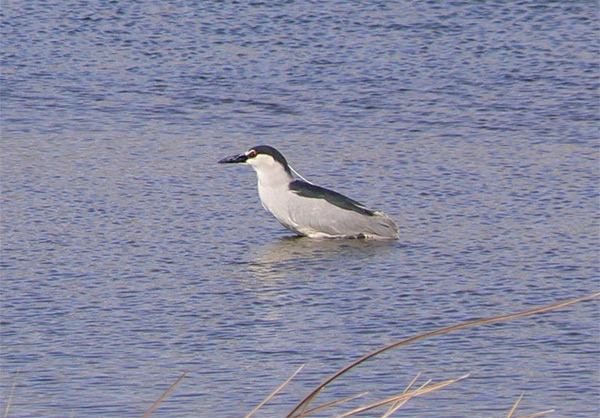 |
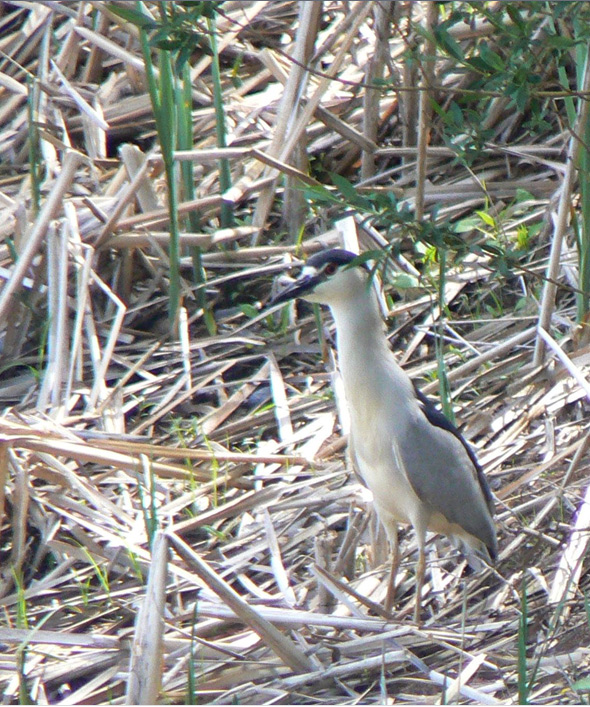 |
The Black-Crowned Night Heron (Nycticorax Nycticorax) is a stocky, short-necked and short-legged heron that seldom extends its neck. The adult is mostly white or gray, with a black crown, shoulders, and back. Adult plumage is reached in the third year; younger birds look mostly like brownish versions of their parents. The adult has red eyes, a black, thick beak, yellow legs, and in breeding season, a couple of long white cord-like head plumes down the back of the neck. It flies heavily and has a flat, raucous quawk as its call. According to an old bird book, ďQuawkĒ was one of its earlier common names.
Its feeding habitat is marshland with slow creeks or ponds. Its hunting posture is hunched over (above, left), intent on seeking the frogs or fish that constitute its main foods. Most of its feeding takes place in the evening after dusk; during the day, it usually rests or roosts. The Heron will often fly a considerable distance from its nest to feed.
These Herons nest together, often in large groups, in isolated patches of woods. Their nests are large loose affairs of branches and twigs. A typical clutch is three to six pale sea-green eggs. Many pairs raise two broods in a summer, so it is not uncommon at the heronry to see parents feeding two sets of offspring, juvenals clamoring about in the branches and fledglings still in the nest.
Black-Crowned Night Herons nest from southern Canada southward throughout North and South America to Patagonia. They winter mainly from the California and Gulf coasts southward, though they may be found year-round in parts of Utah, Arizona, and New Mexico., as well as along the Atlantic coast.
If you would like to
write an article for the Bird of the Month, please contact
Machelle -
machelle13johnson@yahoo.com
Click here for past 'Birds of the Month'.
Field Trip Report
River Lane - June 20, 2015
by Machelle Johnson
Fifteen birders met this morning for a Utah County Birders field trip to River
Lane. We met in the Samís Club parking lot and started off with a few species,
then drove on to River Lane. It was a beautiful morning, warm and sunny. The air
was filled with the sounds of Yellow Warblers, American Goldfinches and Bullocks
Orioles. We birded the road and spent some time on Sandy Beach. Thanks to all
who joined us, especially the new birders who were attending for the first time.
We hope to see you again!
We met up with Alona on the road, who told us about a Blue Grosbeak she had seen
on her way in. On our way out, Sheryl, Amana and I were able to see it as well.
We were the last ones out so I donít know if others saw it as they were leaving.
A Barn Owl was flushed about half way down the dirt
road. It flew West over the road, over the heads of some of the birders, for a
bit before ducking into the trees. It was spotted again as it was being mobbed
by some small, annoyed birds. I didnít get a look at what was mobbing it, I was
watching the owlÖ
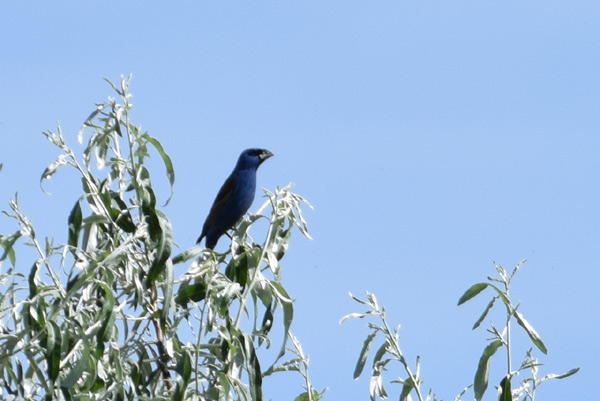 |
|
Blue Grosbeak |
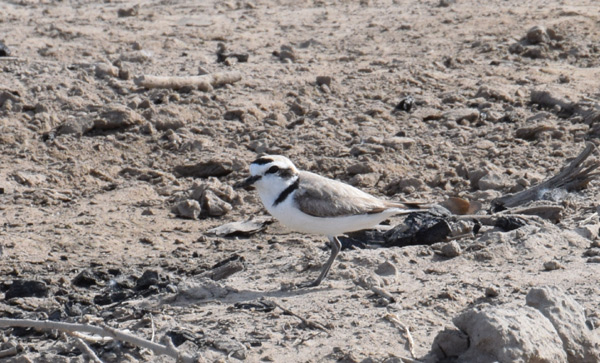 |
|
Snowy Plever |
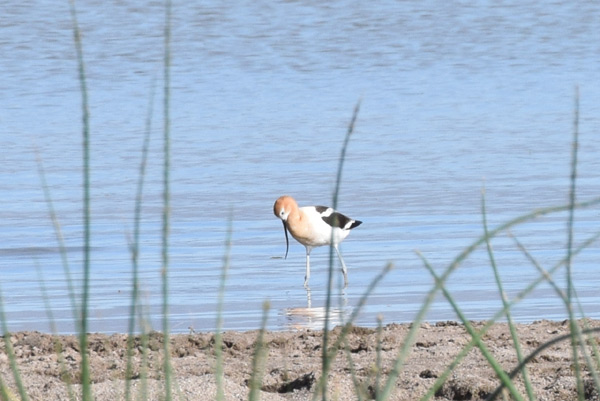 |
|
American Avocet |
Samís Club Parking lot:
Great-tailed Grackle
Black-capped Chickadee
American Goldfinch
River Lane:
Barn Swallow
Bank Swallow
Northern Harrier
Orange-crowned Warbler
Eastern Kingbird
Western Kingbird
Western Meadowlark
Mourning Dove
Eurasian-collared Dove
Black-billed Magpie
Starling
House Finch
Red-winged Blackbird
Yellow Warbler
Brown-headed Cowbird
Bullocks Oriole
Song Sparrow
Barn Owl
Canada Goose
Rock Pigeon
House Sparrow
American Robin
Common Raven
Blue Grosbeak
Western Wood Pewee (Heard only)
Ring-necked Pheasant (Heard only)
(Duck sp. fly over)
Sandy Beach:
Killdeer
Yellow-headed Blackbird
Caspian Tern
Snowy Egret
American White Pelican
Clarkís Grebe
Snowy Plover (5)
California Gull
Ring-billed Gull
Black-necked Stilt
American Avocet
Double-crested Cormorant
Willett
Osprey
Spotted Sandpiper
June 2015
Jack Binch - Sandy
A couple of California Quail ignored the kestrels and came into the yard. The kestrels have fledged and maybe I can get a few small birds now. Saved a lot on bird seed the past couple of months.
Yvonne Carter - American Fork
I think I have a hawk close by. I have some of the usual--Western
Scrub Jays,
chickadees,
finches,
California Quails
in the bushes -- but not the unique species that I usually get in April through
June. Found two dead robins on the grass in the last week.
Herb Clayson - Salem
As I was filling my feeders in the front yard a male Bullock's Oriole
flew into the area.
Eric Huish - Pleasant Grove
Yellow Warbler - I get them each summer. They are fun to watch and hear singing in the mornings.
Milt Moody - Provo
In my Provo backyard I had three juvenile
Western Screech-Owls come to my bird bath three mornings in a row at dawn
and take turns taking a bath. I was alerted to their presence with some
back-and-forth calling through my open window around 5:30 AM each morning.
Dennis Shirley - Elk Ridge
Add one more Band-tailed Pigeon to the Utah County yard bird records for
the summer. I had my first ever on June 6, 2015. He stayed around till the 12th
and haven't seen him since.
Alton Thygerson - Provo
California Quail chicks - Watching 9 of these fuzz-balls brings a smile
as Mom and Dad herd them from place-to-place.
Report your favorite backyard bird
each month to Eric Huish at 801-360-8777 or
erichuish@gmail.com
The Utah County Birders Newsletter is now online only/mostly.
We've decided to stop the regular paper mail version of the UCB Newsletter. This will save our club on Printing, Postage and Paper. If you would like an email notice each month when the Newsletter is posted online please send an email to Eric Huish at erichuish@gmail.com.
We are willing to print the online version of the newsletter and mail it out to anyone who still wants a paper copy or who doesn't have internet access. If you know of anyone who enjoys the UCB Newsletter but doesn't have internet access please let Eric Huish or Keeli Marvel know and we will make sure they get a copy.
Printable Version of this UCB Newsletter